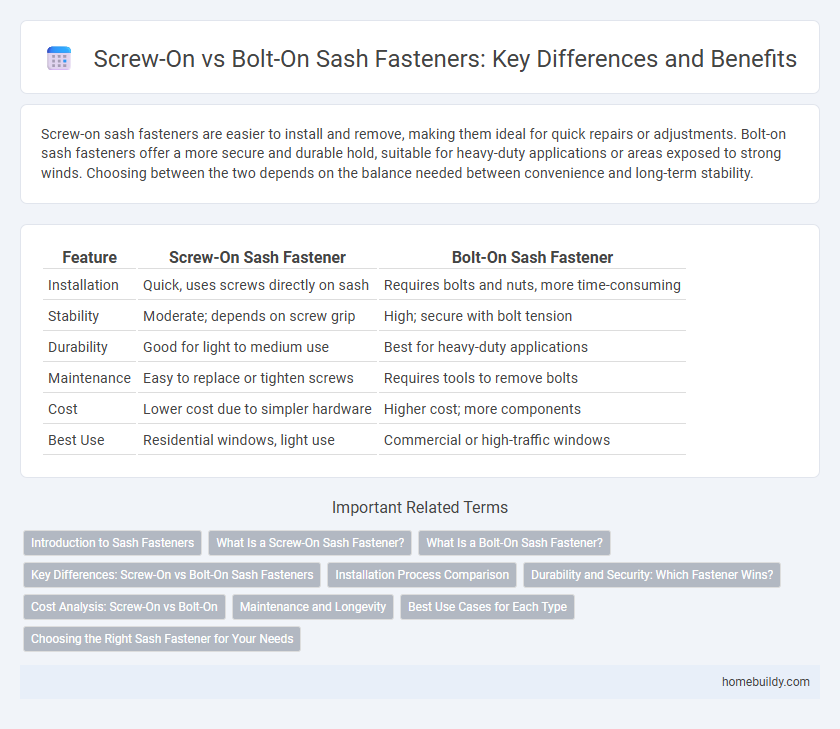Screw-on sash fasteners are easier to install and remove, making them ideal for quick repairs or adjustments. Bolt-on sash fasteners offer a more secure and durable hold, suitable for heavy-duty applications or areas exposed to strong winds. Choosing between the two depends on the balance needed between convenience and long-term stability.
Table of Comparison
| Feature | Screw-On Sash Fastener | Bolt-On Sash Fastener |
|---|---|---|
| Installation | Quick, uses screws directly on sash | Requires bolts and nuts, more time-consuming |
| Stability | Moderate; depends on screw grip | High; secure with bolt tension |
| Durability | Good for light to medium use | Best for heavy-duty applications |
| Maintenance | Easy to replace or tighten screws | Requires tools to remove bolts |
| Cost | Lower cost due to simpler hardware | Higher cost; more components |
| Best Use | Residential windows, light use | Commercial or high-traffic windows |
Introduction to Sash Fasteners
Sash fasteners are essential components for securing window sashes, with screw-on and bolt-on types offering distinct installation methods and durability. Screw-on sash fasteners are easier to install, requiring only screws to attach directly to the frame, making them ideal for lightweight or wooden windows. Bolt-on sash fasteners provide enhanced strength and security through a bolt mechanism, suitable for heavier or metal window frames where added stability is critical.
What Is a Screw-On Sash Fastener?
A screw-on sash fastener is a hardware component designed to secure window sashes by being directly screwed into the frame or sash, providing a tight and secure hold. Unlike bolt-on sash fasteners, which require bolts and nuts for installation, screw-on fasteners are easier to install and often used in lighter or standard window applications. Their design enhances window security and stability while allowing for straightforward maintenance or replacement.
What Is a Bolt-On Sash Fastener?
A bolt-on sash fastener is a type of window hardware designed to secure sash windows by attaching directly through the window frame with bolts, providing enhanced strength and durability compared to screw-on options. These fasteners are typically used in heavier or larger sash windows where additional security and stability are required. The installation process involves drilling holes and tightening bolts, ensuring a firm and long-lasting hold that resists forced entry and wear over time.
Key Differences: Screw-On vs Bolt-On Sash Fasteners
Screw-on sash fasteners are attached directly by driving screws into the window frame, offering easy installation and removability, which suits wooden window frames. Bolt-on sash fasteners require nuts and bolts for a more secure and durable fastening, ideal for heavier or metal frames where increased strength is necessary. The choice between screw-on and bolt-on sash fasteners depends on frame material, load requirements, and desired longevity of the window security solution.
Installation Process Comparison
Screw-on sash fasteners offer a straightforward installation process, requiring only basic tools such as a screwdriver and pre-drilled holes to secure the fastener directly to the window frame. Bolt-on sash fasteners demand a more involved procedure, often necessitating drilling holes for bolts and nuts, along with proper alignment to ensure a secure fit, which can increase installation time and complexity. The screw-on method is generally preferred for quick retrofits or repairs, while bolt-on fasteners provide enhanced durability for heavy-duty applications.
Durability and Security: Which Fastener Wins?
Screw-on sash fasteners typically offer superior durability due to their direct engagement with the wood, reducing the risk of loosening over time compared to bolt-on fasteners that rely on nuts and washers. In terms of security, screw-on fasteners provide a tighter, more stable hold, making them more resistant to forced entry or environmental wear. Bolt-on sash fasteners may be easier to install but generally lack the long-term strength and security benefits inherent to screw-on designs.
Cost Analysis: Screw-On vs Bolt-On
Screw-on sash fasteners generally offer a lower initial cost due to simpler installation processes and reduced labor requirements compared to bolt-on sash fasteners. Bolt-on sash fasteners, while more expensive upfront, provide enhanced security and durability that may lower long-term maintenance and replacement expenses. Evaluating total cost of ownership favors screw-on fasteners for budget-sensitive projects, whereas bolt-on options are cost-effective for applications demanding higher performance and longevity.
Maintenance and Longevity
Screw-on sash fasteners require periodic tightening and inspection to prevent loosening over time, which can affect window security and alignment. Bolt-on sash fasteners generally offer enhanced durability and stability with reduced maintenance, as their installation provides a firmer grip less prone to wear and vibration. Choosing bolt-on fasteners typically extends the lifespan of sash hardware by minimizing the need for frequent adjustments and replacements.
Best Use Cases for Each Type
Screw-on sash fasteners are ideal for lightweight wooden or composite window frames due to their easy installation and adjustability, providing reliable security in residential settings. Bolt-on sash fasteners suit heavier or metal window frames, offering enhanced durability and resistance to tampering, making them perfect for commercial buildings or high-traffic areas. Selecting the appropriate fastener type depends on frame material, window weight, and desired security level to ensure optimal performance.
Choosing the Right Sash Fastener for Your Needs
Screw-on sash fasteners offer easy installation and are ideal for lightweight wooden or uPVC windows, providing secure closure with minimal tools. Bolt-on sash fasteners deliver enhanced strength and durability, making them suitable for heavy timber frames or high-security applications where a robust lock is essential. Selecting the right sash fastener depends on window material, required security level, and ease of installation preferences.
screw-on sash fastener vs bolt-on sash fastener Infographic

 homebuildy.com
homebuildy.com